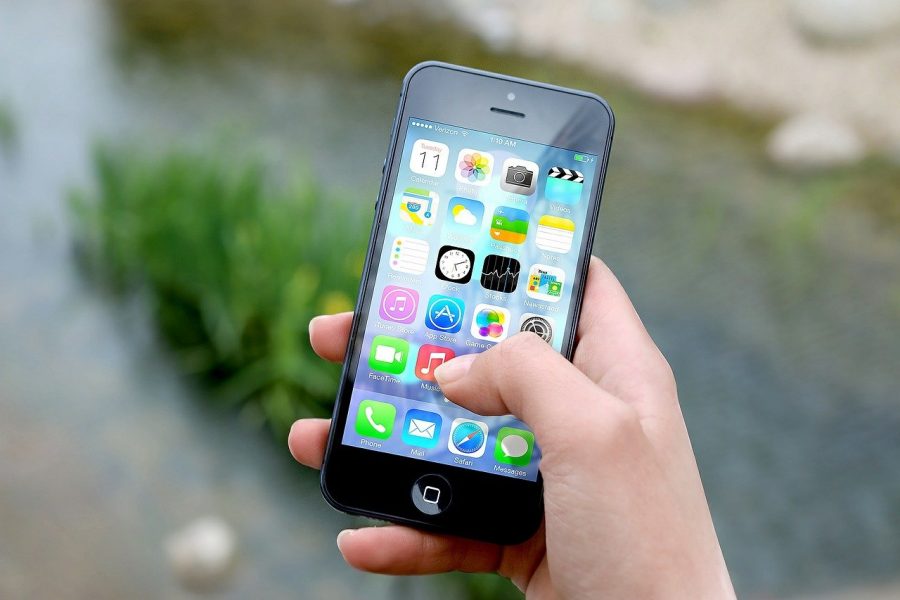Cell Phones: the next epidemic?
The monotonous pitch of the bell echoes around the room as morning classes come to an end. Freshman Linda Yang observes her fellow students in the hallways as she hurries to her next class. A couple students slide past her, headphones stuffed into their ears as their heads move to upbeat music. Down the hallway, a group of giggling girls cluster together as they stare excitedly at their small screens, relaying some of the latest gossip and news from around school. Five minutes until next hour starts. Turning a corner, a group of athletes are in a huddle, laughing uncontrollably at a video one of them has on his phone. Peeping into a classroom, Yang sees half the desks occupied with students. Some are talking to each other but most are on their devices, oblivious to what is going on around them.
“If I were (superhero) Thanos, I would erase half the phones in the universe,” said social studies teacher Stephen Hathaway to his class one day. Indeed, phones have become a huge distraction in classrooms, and an increasing number of teachers now include specific policies regarding technology in the classroom. Many of them even choose to hang phone pockets in their rooms for students to leave their devices in so as to prevent any possible interruption during class.
According to a 625-student study conducted in 26 states by the University of Nebraska-Lincoln, “(college) students check their phones and other digital devices in class more than 11 times a day on average, and it’s not just a quick glance to see if someone’s trying to reach them.” Students in the study estimated that, on average, they spend 20 percent of their class time using digital devices for activities unrelated to class—mostly text messaging but also emailing, web-surfing, checking social media and even playing games.
That can add up. Barney McCoy, associate professor of broadcasting and journalism who conducted the survey, said that the average student may be distracted for two-thirds of a school year during the typical four years they’re in college classrooms.
Students, however, don’t believe phones are a major distraction in class. “I think teachers are making cell phones a much bigger problem than they actually are. The kids that are on their phones during class aren’t going to pay attention even if you take their phone away, they’ll just stare at the wall or find something to fiddle with,” said freshman Erika Chen. “Teachers are a bit too cagey about them.”
“Lots of kids use their phones during class to google things that help them on their classwork,” freshman Jenny Sun said in agreement. “It’s not like phones can’t be helpful to us during class.”
Undoubtedly, different teachers take varying approaches in undertaking the issue of phones in classrooms. While some choose to hang cell phone pockets in their classrooms, others, like English teacher Maria Montri, think differently. “I feel like it’s more disruptive to fight with kids to put them away all the time than it is for them to just make the decision to not be paying attention,” she said. “They’re young adults; they should be able to find out when they should and when they shouldn’t be doing stuff.”
One thing both students and teachers can agree on is how big of a part cell phones have taken in most of our lives now; almost everybody has one. “I really feel like it’s just engrained in how we go about our business. Everybody goes crazy if they can’t find it or touch it,” said French teacher Madame Hanrath.
Research on modern cell phone addiction has produced staggering results. According to Business Insider, iPhone users unlock their phones an average of 80 times per day, while a study of Android users found that they unlock their phones 110 times per day. This means that, in an average day of usage, iPhone users check their phones six to seven times per hour, or once every 10 minutes. Even more surprising was a recent study published by King University stating that people tap, swipe, and click an average of 2,617 times per day. For the top 10 percent of users, this number doubles to 5,427 touches per day. That’s about 1 million touches per year and 2.42 hours of phone screen time per day. More serious users interacted with their phones even more, at 3.75 hours per day. This data includes all types of interactions, from reading and sending texts to scrolling on social media.
Tech dependency is a modern issue that is growing in relevance and most of us don’t even realize it. “People are probably on their phones way more than they think,” said sophomore Sidney Shelton. “I’m on my phone for up to four hours a day, and that’s crazy.” With a world as tech dependent as we are, it’s hard to go through class without a phone.
“Right now, cell phone use is at its peak,” said Hanrath. “I hope someday that people are going to see the devastation, like people getting depressed and people not talking to each other anymore and people being so into their own little worlds that I really think we’re going to start seeing a trend back.”


